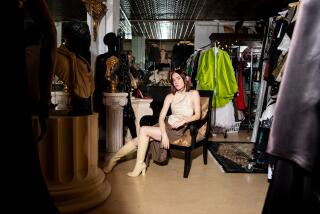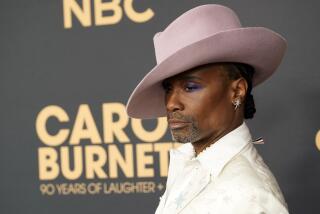The Revision of a Fashion Bible
- Share via
Forty-eight hours after executives of Hearst Magazines approached Kate Betts about taking the reins at Harper’s Bazaar, she created a dummy version of the fashion monthly that eventually won her the editor in chief post. On June 27, three days after accepting the high-profile job, the 35-year-old Betts gave birth to her first child, the 10-pound, 6-ounce Oliver.
She worked through a two-month maternity leave and officially assumed her new editor duties Sept. 1. The dual tasks of revitalizing the legendary magazine and raising her first child is an effort that Betts called her “twins.”
This week, the fruit of her other labor--the redesign of the country’s oldest fashion magazine--arrives in subscribers’ mailboxes. The February issue looks as changed but recognizable as the celebrity on its cover--a newly brunet Gwyneth Paltrow. It has a cleaner look, new, clearly identifiable sections, and new contributors.
Betts, formerly the fashion news director at Conde Nast’s Vogue, also plans a Web site, TV show and documentary. She succeeds the enormously popular Liz Tilberis, who, at 51, died of ovarian cancer in April. During her six-year tenure, Tilberis gave the magazine an award-winning redesign, and Bazaar came to be known for its cutting-edge photography and page design.
Now the magazine faces challenges. Among the top fashion magazines, Bazaar has slipped in advertising pages, circulation and, as a result, cachet. Its 732,572 circulation is well behind the 1.2-million circulation of Vogue. In ad pages, Bazaar is fourth behind Vogue, Elle and W.
The magazine has been noticeably thinner in the last year. Some advertisers, such as Lanco^me, Calvin Klein, St. John and Coach watches have stayed with the magazine during the transition, however.
“I think Harper’s is an institution,” said Scott Woodward, chief marketing officer of the Movado Group, which owns Coach watches. “It’s a really important magazine in the fashion world.”
Some insiders say that Harper’s has slipped from a “must buy” for fashion advertisers, many of whom are increasingly buying ads elsewhere--the Internet, entertainment magazines and even billboards, said Michael Toth, president and executive creative director of Toth Brand Imaging, a New York company that reshapes fashion companies and directs their advertising placements.
But for Barneys New York, Harper’s Bazaar is still important, said Simon Doonan, executive vice president of creative services at the upscale store.
“It’s a very competitive environment now with a lot of different magazines vying for the consumers’ loyalty,” he added. “Even the National Enquirer has fashion in it now. But my money is on Kate.
“She’s a very gutsy kind of gal. However young she was, she never seemed like an ingenue. She has a very authoritative vibe about her--which is what you need to command respect in the fashion world.”
One observer likened Betts’ role to that of President Lyndon Johnson after the death of John F. Kennedy. Filling the shoes of Tilberis has been difficult, Betts said last week in a telephone interview.
“I don’t think you can ever overestimate the tragedy of somebody dying like Liz. I think she did something amazing with Bazaar, which is uphold the visual excellence of this magazine. But to that I want to add great writing,” Betts said.
A preview copy of the February issue, the first to incorporate all of her initiatives, showcases photography by Patrick Demarchelier and writing by Bret Easton Ellis, who wrote about the political correctness backlash. In addition to the novelist, reporters from the New York Times and Newsweek also have contributed stories this month.
“I’m a writer myself. I feel very strongly about good writing,” Betts said. “I don’t think there is a place for too much gratuitous fashion writing. In terms of reporting on fashion, the job of the magazine is to give the reader a point of view and to show them where they should go. They should know from the pictures and the writing that they are in Harper’s Bazaar.”
Toward that goal, Betts, her newly appointed design director, Paul Eustace, and editorial design consultant Michael Grossman have neatly divided the magazine into four sections: the newsy Report; Image for beauty, health and fitness news; Life, a section on the arts; and a back-of-the-book expanded shopping digest, the Bazaar. Each page identifies the section, date and story topic.
The sections aim to present a sense of community and to build reader loyalty, Betts said.
“When we restructured the book, each section was like a different neighborhood, and there were different people in each neighborhood,” she explained.
Betts refers to Harper’s Bazaar as a brand that “can exist on several levels.” In March, she’ll launch the 132-year-old magazine into cyberspace with a new Web site that will coincide with the technology-oriented April issue. The Web site will be more consumer-oriented, with shopping guides, product information and beauty tips, she said.
Also in the works are a television project that she declined to describe and a documentary of her remaking of Bazaar.
But Betts downplays the role of celebrity journalism in Bazaar. She said she was misquoted in reports saying she would remake Bazaar to look like the celebrity-heavy In Style.
“I guess they got confused because I said it would be more about lifestyle and a lifestyle context. In Style was never my idea of a fashion magazine,” she said.
“We are not putting celebrities on every cover. I think that dilutes the whole event of putting a celebrity on the cover. I would like to have them on the cover for a reason . . . because they have great fashion sense, or they represent the theme of the issue in some way.” Paltrow in the February issue, for example, represents a new American image, according to Betts.
Since her arrival, Bazaar has paid more attention to Los Angeles and its celebrity culture, with shopping directories, Hollywood profiles and even a photo shoot at the Playboy mansion. The magazine has also hired a new full-time editor for the West Coast.
In keeping with the more streamlined look of the magazine, Betts has even altered her byline. At Vogue, she was known as Katherine. Now she goes by the name her friends call her, Kate.
Betts grew up in Manhattan as the child of an architect father and photographer mother. She attended the prestigious Choate Rosemary Hall boarding school in Connecticut, and graduated from Princeton in 1986, where she studied European history since the Renaissance, a pursuit that she said has enhanced her view of fashion.
Before working at Vogue, she was the bureau chief of the Paris office of Fairchild Publications, which publishes Women’s Wear Daily and W. She also worked at Metropolitan Home and the International Herald Tribune. At Vogue since 1991, she became the protege of Editor in Chief Anna Wintour, known as a steely but savvy fashion editor because of her multilevel marketing of Vogue and support of emerging designers.
Betts diplomatically downplays reports in the New York Times and the London Guardian of everything from disappointment to declarations of war between the former co-workers. “We always had a professional relationship, and that is what we still have,” she said of Wintour.
In her September editor’s letter, Wintour wrote, “I feel sad that we will now be rivals and will miss sitting next to her at fashion shows.” Oliver Betts, the New York Times reported, received many baby gifts from around the world but none from Wintour.
*
Valli Herman-Cohen can be reached by e-mail at valli.herman-cohen@latimes.com.






